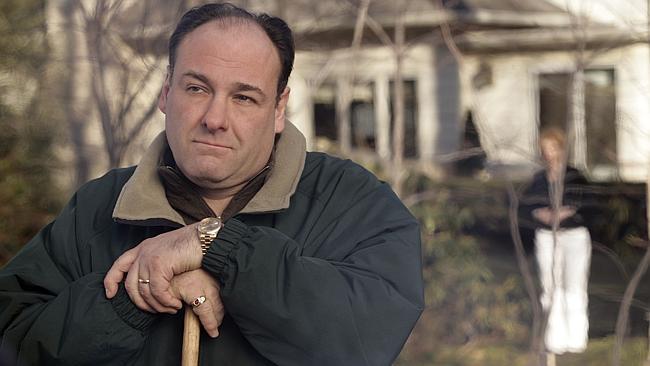Chasing the monster inside the mobster
WHEN James Gandolfini died suddenly last June, aged 51, it was the second time fans had farewelled the actor.

WHEN James Gandolfini died suddenly last June, aged 51, it was the second time fans had farewelled the actor. In 2007 the ambiguous final scene of HBO series The Sopranos inferred it might have been the end for Gandolfini’s most unforgettable creation Tony Soprano, the beguiling, sociopathic mobster who altered our expectations of television protagonists.
Disentangling this larger-than-life character from the actor who played him is the biographer’s primary task, and Dan Bischoff promises to do just that in Gandolfini: The Real Life of the Man Who Made Tony Soprano.
For many years Bischoff was a journalist at The Star-Ledger, the New Jersey newspaper that we so often saw Tony shuffling down the driveway to collect. This middle-class suburbia on the fringes of the great metropolis is a place where Bischoff says high and low culture collide; he sees New Jersey as an attitude, locals sharing “a sort of sad-sack, also-ran, second-rate phobia as their birthright”. And as a New Jersey native son, Bischoff seems to find more correlations between Gandolfini and his crooked alter ego than divergences.
After immigrating from Italy to the US, the Gandolfini family chased the American dream across the sprawling suburbs into Park Ridge. His father became a school custodian, his mother a lunch lady. Childhood friends paint the young Gandolfini as a generous rascal. He was voted biggest flirt in his graduating year, yet many say he enjoyed solitude too.
No amount of fame would make Gandolfini turn his back on these humble origins: according to Bischoff’s sources he remained “the regular Jersey guy” and “working-class hero”, never entirely accepting the trappings that came with celebrity. “I’m still grumpy and miserable,” Gandolfini said later, “but in a good way!” The actor’s late-ish success may have had engendered this modesty too. Gandolfini didn’t get his break until the Hollywood-elderly age of 32, playing another volatile gangster in the Quentin Tarantino-penned True Romance in 1993. It wasn’t until he was 38 that he landed his first leading role: as Tony Soprano, a character by turns enchanting and chilling.
Soprano allowed Gandolfini to demonstrate his astounding range, yet like many Italian-American actors, he found mobster typecasting hard to shake. Even at the height of his career, Bischoff argues that Gandolfini never transcended the insecurity of that Jersey mindset; the actor would routinely try to quit every role, always offering the director a list of actors who could do the job better.
An adherent of the invasive Meisner technique (an acting method that draws heavily on personal life experiences), Gandolfini struggled as The Sopranos went on to plumb what series creator David Chase saw as Gandolfini’s own “turmoil … pain and sadness”. (Bischoff’s best interviews are those with Gandolfini’s acting teachers and long-time coach.)
Gandolfini began to disappear from set for days at a time and was reported to have drug and alcohol problems. Bischoff suggests Gandolfini’s genius lay in “his ability to find sympathy with the devil within the characters he played”, yet the “monster” inside, the one that Bischoff claims drove the actor to his heights, remains frustratingly obscure.
Published a year after Gandolfini’s death, it must have been a rush to get this biography to print. It shows. The already-slim volume repeats several quotes and observations basically verbatim, and it is peppered with clunky syntax and bizarre similes: talking about the rise of the drinking age to 21, Bischoff says “campus pubs shrank back to their larval stage as if they’d eaten magic mushrooms”, and Gandolfini’s fame happens “like a pile of old newspapers falling on a hoarder”. Bischoff spends copious pages describing Gandolfini’s various roles, but his powers of interpretation are limited.
In Bischoff’s defence, he must have had his work cut out for him. Gandolfini was notoriously media shy, deflecting personal questions with a cry of “Boriiiing!” Friends, family and colleagues honour that privacy, leaving Bischoff mostly peripheral figures to interview, such as college acquaintances or the Park Ridge mayor.
Still, a more nimble writer could have overcome, at least to some extent, these issues. GQ correspondent Brett Martin’s Difficult Men, a study of the long-form TV drama that The Sopranos kick-started, begins with a lucid scene describing one of Gandolfini’s longest disappearing acts, when the actor absconded for four days from a shoot that had required an entire airport to be shut down. This one episode offers a more vivid snapshot of Gandolfini’s volatility than Bischoff’s entire book.
It is Gandolfini’s role in Nicole Holfcener’s Enough Said (released posthumously) where we glimpse what he is capable of, playing a fragile romantic lead poles apart from Soprano’s brutish charms. Bischoff’s account, in contrast, fails to uncover such hidden facets of the man who was Tony Soprano, but also much more.
Rebecca Harkins-Cross is a writer and critic.
Gandolfini: The Real Life of the Man Who Made Tony Soprano
By Dan Bischoff
Scribe, 280pp, $27.99


